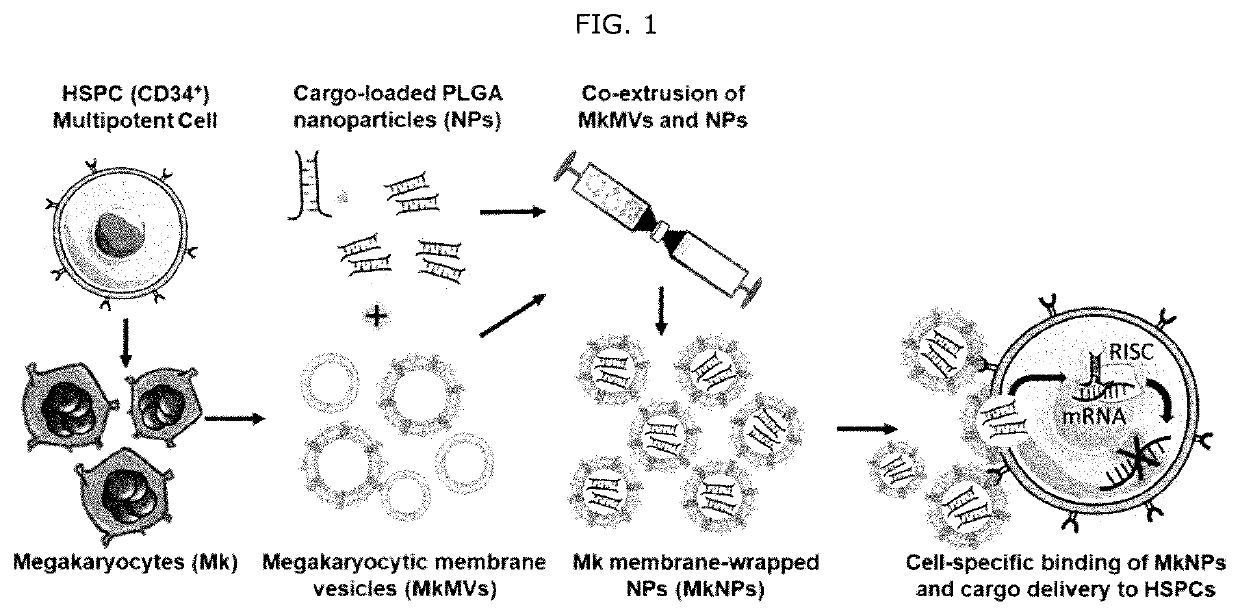Biomembrane-covered nanoparticles (bionps) for delivering active agents to stem cells
a technology of biomembrane-covered nanoparticles and stem cells, which is applied in the direction of antibacterial agents, drug compositions, immunological disorders, etc., can solve the problems of poor dna insertion, limited loading capacity of viral vectors, and long-standing problem of cargo delivery to hspcs
- Summary
- Abstract
- Description
- Claims
- Application Information
AI Technical Summary
Benefits of technology
Problems solved by technology
Method used
Image
Examples
examples 1-4
D CHARACTERIZATION OF BIONPS CONTAINING HYDROPHOBIC CARGO
[0082]To demonstrate the synthesis of BioNPs containing hydrophobic molecules, we used DiD fluorophores as model cargo, as this allows visualization of cargo delivery to HSPCs by fluorescence microscopy. In short, we synthesized PLGA NPs encapsulating DiD by the method described above method by dissolving 50:50 PLGA with an inherent viscosity of 0.67 dL / g in acetone along with DiD fluorophores and adding this mixture dropwise to water in a 1:3 ratio. We have adjusted the concentration of PLGA used in this synthesis from 1 to 4 mg / mL, resulting in particles ranging from 50 to 120 nm diameter. Likewise, we have used the above lysis and homogenization method to produce MkMVs approximately 150 nm in diameter, and we have co-extruded these MkMVs with DiD-loaded PLGA NPs to produce Mk membrane-wrapped BioNPs. The resultant BioNPs were characterized by several techniques, summarized below.
example 1
e Successfully Wrapped with Mk-Derived Membranes
[0083]The successful production of BioNPs was confirmed by using transmission electron microscopy (TEM) of uranyl-acetate stained samples to visualize unwrapped (bare) PLGA NPs, empty MkMVs, and Mk membrane-wrapped BioNPs (FIG. 2A). As seen in these images, bare PLGA NPs have a homogenous spherical shape and MkMVs appear as hollow shells. By comparison, Mk membrane-wrapped BioNPs have core / shell structure indicative of PLGA NPs (brighter interior) surrounded by Mk-derived biological membranes (darker exterior).
[0084]The hydrodynamic diameter and zeta potential of bare NPs, MkMVs, and BioNPs were also measured to corroborate the TEM findings and confirm successful membrane wrapping. As shown in FIG. 2B, BioNPs are slightly larger than bare PLGA NPs, but smaller than empty MkMVs (which typically have a mean diameter ranging from 140-160 nm). In general, we have found by TEM and nanoparticle tracking analysis (NTA) that BioNPs are 10-20 n...
example 2
intain the Membrane Composition of Their Source Cells
[0085]For BioNPs to maintain the unique HSPC-specific targeting capabilities of Mk cells and MkMPs, they must retain the characteristic membrane proteins. To confirm membrane composition is preserved after wrapping, we synthesized BioNPs as above, and then incubated the samples with a solution of 1-μm streptavidin beads decorated with antibodies against CD41, a surface marker of Mks. The antibodies on the beads can bind CD41 found on BioNPs, whole Mk cells, and empty Mk membrane vesicles. The samples can then be incubated with FITC-labeled anti-CD41 antibodies and analyzed by flow cytometry to determine the relative amount of CD41 present in each group. As shown in FIG. 2D, using this technique we determined that the fraction of streptavidin beads exhibiting positive CD41 signal in the case of whole Mk cells was approximately 85%, which reduced to approximately 75% for empty MkMVs and fully wrapped BioNPs. This indicates that CD41...
PUM
| Property | Measurement | Unit |
|---|---|---|
| Biological properties | aaaaa | aaaaa |
| Hydrophobicity | aaaaa | aaaaa |
| Electrostatic interaction | aaaaa | aaaaa |
Abstract
Description
Claims
Application Information
 Login to View More
Login to View More - R&D
- Intellectual Property
- Life Sciences
- Materials
- Tech Scout
- Unparalleled Data Quality
- Higher Quality Content
- 60% Fewer Hallucinations
Browse by: Latest US Patents, China's latest patents, Technical Efficacy Thesaurus, Application Domain, Technology Topic, Popular Technical Reports.
© 2025 PatSnap. All rights reserved.Legal|Privacy policy|Modern Slavery Act Transparency Statement|Sitemap|About US| Contact US: help@patsnap.com



